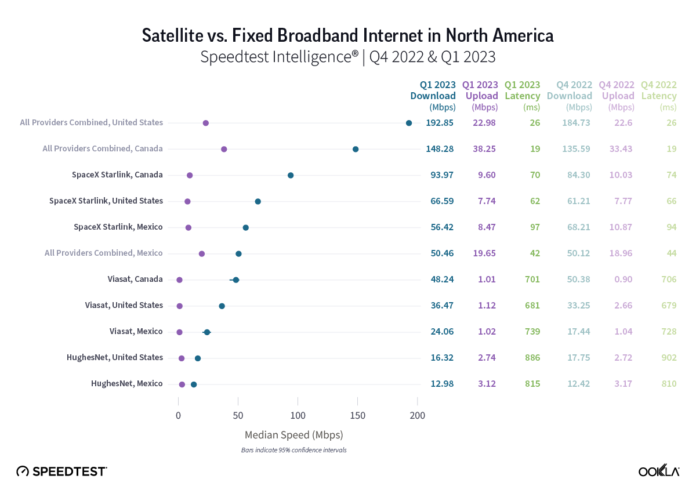Starlink Canada is the fastest satellite provider in North America: Ookla report
11 de Mayo de 2023 a las 09:40

Photo courtesy of Getty Images
Article courtesy of Ashee Pamma, IT World Canada
TORONTO. - New speed test data from Ookla shows that SpaceX Starlink in Canada is the fastest satellite provider in mainland North America.
This comes as the company expedited major upgrades in its satellite array and launched another 46 next gen satellites on Apr. 27.
Ookla’s analysis looked at year-over-year data from HughesNet, SpaceX’s Starlink, and Viasat in North America, South America, and the Caribbean, as well as new Starlink markets.
According to the report, Starlink in Canada had the fastest download speed among satellite providers in North America in Q1 2023, at 93.97 Mbps. This was about 40 per cent faster than the runner-up, which was Starlink in the U.S..
Starlink in Canada also achieved the fastest satellite upload speed, at 9.60 Mbps, followed by Starlink in Mexico (8.47 Mbps) and the U.S. (7.74 Mbps).

Source: Ookla report- Starlink performance in North America in Q4 2022-Q1 2023
However, Starlink, followed by Viasat and HughesNet, continues to trail behind all fixed broadband providers.
The U.S, where Starlink has many more users, saw a 13 Mbps increase during Q4 2022 and Q1 2023, yet recorded a 24 Mbps decrease year-over-year.
Canada also saw a minor decrease in download speed from Q1 2022 to Q1 2023 but surged by 28 Mbps over the past two quarters.
.jpg)
Starlink performance in Canada, U.S., Chile and Mexico, from Q1 2022 to Q1 2023
Further, the report revealed that Starlink is most popular among rural users who often don’t have many good — if any — internet options, the report read.
Nonetheless Starlink is set to face stronger competition as more satellite projects are seeing the light of day. Some include:
–Project Kuiper, Amazon’s Low Earth orbit (LEO) satellite network. After the project got greenlit by the FCC, Amazon showcased consumer terminals, with models to deliver 100 Mbps and 400 Mbps for consumers and businesses, and 1 Gbps models for enterprises, government, and telecommunications applications that require even more bandwidth.
–Viasat-3 arrays, which aims to provide 1 Terabit per second (Tbps) of network capacity on each satellite. With two more satellites, Viasat could allow its users to experience 100+ Mbps connections
–EU’s multi-orbit, €6 billion constellation plan, which includes GEO ( Geostationary equatorial orbit), MEO (Medium Earth orbit), and LEO arrays, and which will offer connectivity to all EU citizens.











Comentarios
escribenos